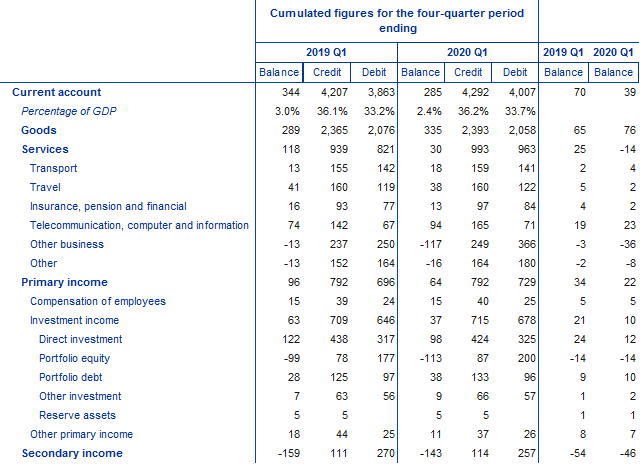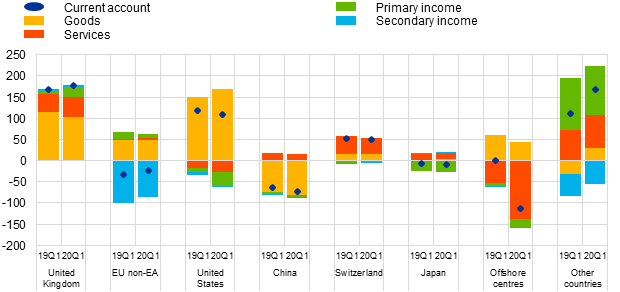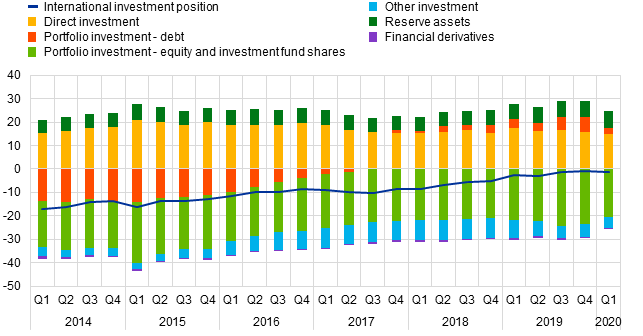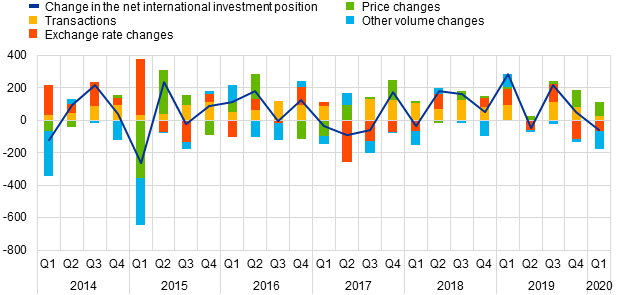- STATISTICAL RELEASE
- 3 July 2020
Euro area quarterly balance of payments and international investment position: first quarter of 2020
- Current account surplus at €285 billion (2.4% of euro area GDP) in four quarters to first quarter of 2020, down from €344 billion (3.0% of euro area GDP) a year earlier
- Geographic counterparts: largest bilateral surpluses vis-à-vis United Kingdom (€178 billion, up from €169 billion a year earlier) and United States (€108 billion, down from €118 billion), with largest deficits vis-à-vis offshore centres (€113 billion, up from €1 billion) and China (€72 billion, up from €64 billion)
- International investment position at end of first quarter 2020 showed net liabilities of €143 billion (around 1% of euro area GDP), after net liabilities of €80 billion at end of previous quarter
Current account
The current account surplus of the euro area declined to €285 billion (2.4% of euro area GDP) in the four quarters to the first quarter of 2020, from €344 billion (3.0% of euro area GDP) a year earlier (see Table 1). This decrease reflected smaller surpluses for services (down from €118 billion to €30 billion) and primary income (down from €96 billion to €64 billion). These developments were partly offset by an increase in the surplus for goods (from €289 billion to €335 billion) and a lower deficit for secondary income (down from €159 billion to €143 billion).
The smaller surplus for services was mainly due to an increase in the deficit for other business services (from €13 billion to €117 billion) that was only partially offset by an increase in the surplus for telecommunication, computer and information services (from €74 billion to €94 billion). This is explained by increased imports of research and development services under other business services. Furthermore, there was a decline in the surpluses for travel (down from €41 billion to €38 billion) and insurance, pension and financial services (down from €16 billion to €13 billion), while the surplus for transport increased (from €13 billion to €18 billion).
The decrease in the primary income surplus was mainly due to decreases in the surpluses for investment income (from €63 billion to €37 billion) and other primary income (from €18 billion to €11 billion). The developments in investment income mainly reflected a lower surplus for direct investment income (down from €122 billion to €98 billion) and a larger deficit for portfolio equity income (up from €99 billion to €113 billion). The increase in the surplus for portfolio debt income (from €28 billion to €38 billion) partly offset the previous changes.
Current account of the euro area
(EUR billions, unless otherwise indicated; transactions during the period; non-working day and non-seasonally adjusted)

Source: ECB.Notes: “Equity” comprises equity and investment fund shares. Discrepancies between totals and their components may arise from rounding.
Data on the geographic counterparts of the euro area current account (see Chart 1) show that in the four quarters to the first quarter of 2020 the euro area recorded its largest bilateral surpluses vis-à-vis the United Kingdom (€178 billion, up from €169 billion a year earlier), a residual group of other countries (€167 billion, up from €112 billion), the United States (€108 billion, down from €118 billion) and Switzerland (€49 billion, down from €51 billion). The largest bilateral deficits in the euro area current account were recorded vis-à-vis offshore centres (€113 billion, up from €1 billion) and China (€72 billion, up from €64 billion).
The most significant geographic changes in the goods balance in the four quarters to the first quarter of 2020 relative to the previous year were an increase in the surplus vis-à-vis the United States (from €151billion to €169 billion), a decrease in the surplus vis-à-vis offshore centres (from €60 billion to €45 billion) and a shift from a deficit to a surplus vis-à-vis a residual group of other countries (from a deficit of €31 billion to a surplus of €30 billion), reflecting in particular a decrease in the deficit vis-à-vis Russia (from €26 billion to €8 billion). In services, increased deficits vis-à-vis offshore centres (up from €53 billion to €137 billion) and the United States (up from €16 billion to €28 billion) were recorded. Moreover, the primary income deficit vis-à-vis the United States increased from €12 billion to €32 billion and the surplus vis-à-vis the United Kingdom from €8 billion to €25 billion.
Geographical breakdown of the euro area current account balance
(four-quarter moving sums in EUR billions; non-seasonally adjusted)

Source: ECB.Note: “EU non-EA” comprises EU Member States and EU institutions outside the euro area. “Other countries” includes all countries and country groups not shown in the chart, as well as unallocated transactions.
International investment position
At the end of the first quarter of 2020 the international investment position of the euro area recorded net liabilities of €143 billion vis-à-vis the rest of the world (around 1% of euro area GDP), compared with net liabilities of €80 billion in the previous quarter (see Chart 2 and Table 2).
Net international investment position of the euro area
(net outstanding amounts at end of period as a percentage of four-quarter moving sums of GDP)

Source: ECB.
This deterioration of €63 billion reflected large but partly offsetting changes in the various investment components. Lower net assets for portfolio debt (€299 billion, down from €752 billion) and direct investment (€1,758 billion, down from €1,880 billion) were partially offset by lower net liabilities for portfolio equity (€2,458 billion, down from €2,787 billion) and for other investment (€537 billion, down from €690 billion).
International investment position of the euro area
(EUR billions, unless otherwise indicated; amounts outstanding at the end of the period, flows during the period; non-working day and non-seasonally adjusted)

Source: ECB.Notes: “Equity” comprises equity and investment fund shares. Net financial derivatives are reported under assets. Discrepancies between totals and their components may arise from rounding.
The change in the euro area’s net international investment position in the first quarter of 2020 was driven mostly by net negative exchange rate changes and other volume changes that were only partially compensated by net positive price changes and transactions (see Chart 3).
The decrease in net assets for portfolio debt was due to all its components, namely negative transactions, net revaluations and other volume changes (see Table 2), while lower net assets for direct investment resulted mainly from negative net revaluations that were partly compensated by positive transactions. The decrease in net liabilities for portfolio equity stemmed mainly from positive net price revaluations, as the effect of the decline in prices was larger for liabilities than for assets. The lower net liabilities for other investment resulted mainly from transactions.
At the end of the first quarter of 2020 the gross external debt of the euro area totalled €15.3 trillion (around 129% of euro area GDP), which represents an increase of €776 billion compared with the previous quarter.
Changes in the net international investment position of the euro area
(EUR billions; flows during the period)

Source: ECB.Note: “Other volume changes” mainly reflect reclassifications and data enhancements.
Data revisions
This statistical release incorporates revisions to data for the reference periods between the first quarter of 2016 and the fourth quarter of 2019. The revisions reflect revised national contributions to the euro area aggregates as a result of the incorporation of newly available information.
Next releases
- Monthly balance of payments: 20 July 2020 (reference data up to May 2020)
- Quarterly balance of payments and international investment position: 2 October 2020 (reference data up to the second quarter of 2020)
For queries, please use the Statistical information request form.
Notes
- All data are neither seasonally nor working day-adjusted. Ratios to GDP (including in the charts) refer to four-quarter sums of non-seasonally and non-working day-adjusted GDP figures.
- Hyperlinks in the statistical release refer to data that may change with subsequent releases as a result of revisions.
Europese Centrale Bank
Directoraat-generaal Communicatie
- Sonnemannstrasse 20
- 60314 Frankfurt am Main, Duitsland
- +49 69 1344 7455
- media@ecb.europa.eu
Reproductie is alleen toegestaan met bronvermelding.
Contactpersonen voor de media

